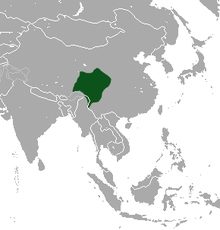Chinese water shrew
| Chinese water shrew | ||||||||||||
|---|---|---|---|---|---|---|---|---|---|---|---|---|
| Systematics | ||||||||||||
|
||||||||||||
| Scientific name | ||||||||||||
| Chimarrogale styani | ||||||||||||
| de Winton , 1899 |
The Chinese water shrew ( Chimarrogale styani ) is a species of shrew from the genus of the beaver shrews ( Chimarrogale ). It occurs mainly in the center of the People's Republic of China and in Myanmar .
features
With a head-torso length of 9.6 to 10.8 centimeters and a weight of 23 to 56 grams, the species is one of the medium-sized shrew species. The tail reaches a length of 61 to 85 millimeters and the rear foot of 20 to 23 millimeters. Their appearance almost corresponds to that of the Himalayan water shrew ( C. himalayana ), but it is somewhat smaller. The back and belly color is uniformly black-brown and darker than that of the Himalayan water shrew, with the belly side being clearly separated and lighter to woolly white.
| 1 | · | 3 | · | 1 | · | 3 | = 28 |
| 1 | · | 1 | · | 1 | · | 3 |
The skull has a maximum length of 23 to 25 millimeters. Like all species of the genus has the Chinese water shrew maxillary per half an incisor (incisor) and then three, sometimes four, unicuspid teeth, a Vorbackenzahn (premolar) and three molars (molar). In the lower jaw, however, it has a single canine behind the incisor. The animals have a total of 28 teeth. The roots are not colored.
distribution
The Chinese water shrew occurs in a large area in the People's Republic of China and in the neighboring states. In China, the species is found in the provinces of Xizang , Yunnan , Sichuan , Qinghai, and Gansu . The species is also found in northern Myanmar and perhaps also in Arunachal Pradesh in the far northeast of India .
The altitude distribution ranges from 1700 to 3500 meters. In large parts of the distribution area, the species occurs sympatric with the Himalayan water shrew ( C. himalayana ).
Way of life
As with all species of the genus, hardly any data is available on the way of life of the Chinese water shrew. Like all shrews, these species also feed on invertebrates, and the Chinese water shrew probably also feeds on aquatic insects and also prey on small fish. The species lives mainly in the area of clear and cold rivers in forest areas at higher altitudes.
Systematics
The Chinese water shrew is classified as an independent species within the genus of the beaver shrew ( Chimarrogale ), which consists of six species. The first scientific description comes from William Edward de Winton in 1899.
Apart from the nominate form, no subspecies are distinguished within the species .
Threat and protection
The Chinese water shrew is classified by the International Union for Conservation of Nature and Natural Resources (IUCN) as “least concern” due to its relatively large distribution area and the assumed population size. There are no known threats to the species, but habitat destruction such as deforestation and pollution in rivers could have an effect on populations.
literature
- Robert S. Hoffmann, Darrin Lunde: Chinese Water Shrew. In: Andrew T. Smith , Yan Xie: A Guide to the Mammals of China. Princeton University Press, Princeton NJ 2008, ISBN 978-0-691-09984-2 , p. 307.
Web links
- Chimarrogale styani inthe IUCN 2012 Red List of Threatened Species . 2. Posted by: D. Lunde, L. Ruedas, 2008. Retrieved July 1, 2013.
supporting documents
- ↑ a b c d e f Robert S. Hoffmann, Darrin Lunde: Chinese Water Shrew. In: Andrew T. Smith , Yan Xie: A Guide to the Mammals of China. Princeton University Press, Princeton NJ 2008, ISBN 978-0-691-09984-2 , p. 307.
- ↑ a b c d e f Chimarrogale styani in the IUCN Red List of Threatened Species 2012.2. Posted by: D. Lunde, L. Ruedas, 2008. Retrieved July 1, 2013.
- ↑ a b c Chimarrogale styani ( Memento of the original dated November 10, 2013 in the Internet Archive ) Info: The archive link was inserted automatically and has not yet been checked. Please check the original and archive link according to the instructions and then remove this notice. . In: Don E. Wilson , DeeAnn M. Reeder (Eds.): Mammal Species of the World. A taxonomic and geographic Reference. 2 volumes. 3. Edition. Johns Hopkins University Press, Baltimore MD 2005, ISBN 0-8018-8221-4 .
